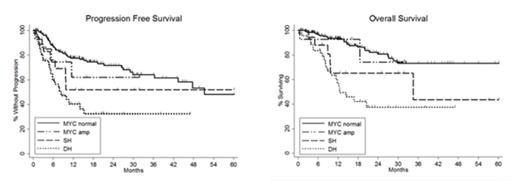Abstract
Introduction
While patients (pts) with diffuse large B cell lymphoma (DLBCL) and B cell lymphoma unclassifiable with features intermediate between DLBCL and Burkitt lymphoma (BCLU) harboring rearrangement of MYC (MYC-R) face a poor prognosis as compared to DLBCL/BCLU pts without MYC-R, the prognosis of DLBCL/BLCU pts with MYC-R in the absence of rearrangements of BCL2 (BCL2-R) and BCL6 (BCL6-R) has not clearly been reported in the literature. Additionally, it is not well known whether amplification of MYC in the absence of MYC-R portends a poor prognosis for DLBCL/BCLU pts. Here, we analyze outcomes for these pts in comparison to DLBCL/BCLU pts without MYC-R or MYC amplification.
Methods
Pts diagnosed with DLBCL or BCLU treated at the University of Pennsylvania and Northwestern University from 3/2002-3/2015 whose diagnostic specimens underwent fluorescence in situ hybridization for MYC-R with8q24 breakapart and/or t(8;14)(q24;q32) fusion probes were included in this analysis. Pts with primary CNS and HIV-associated lymphoma were excluded. Cases with MYC-R but not BCL2-R and BCL6- R were defined as single hit (SH), cases with MYC-R as well as BCL2 -Rand/or BCL6-R as double hit (DH), cases with >4 copies of MYC as amplified (MYC amp) and cases without MYC-R and ≤4 copies of MYC as normal (MYC normal). Therapy was given at the discretion of the treating clinician. Progression free survival (PFS) was defined as time from diagnosis to radiographic progression, regimen change, death or last follow-up. Overall survival (OS) was defined as time from diagnosis to death or last follow-up. Data were censored on 7/1/15.
Results
224 pts were included in the full analysis: 190 MYC normal, 19 SH and 15 MYC amp. An additional 46 DH pts were analyzed for PFS and OS only. No pts were both SH and MYC amp. Pts baseline characteristics were reported as follows: 52% female, 47% age >60 years (yrs), 66% LDH >normal, 62% stage ≥3, 15% lymphomatous involvement of bone marrow, 11% ECOG performance status (PS) >2, 66% extranodal disease, 29% B symptoms, 42% International Prognostic Index (IPI) score ≥3, 4% BCLU histology and 18% low-grade transformation. Only the presence of BCLU histology differed significantly between SH and MYC normal pts (26% vs. 1%, p=0.001) and between MYC amp and MYC normal pts (13% vs. 1%, p=0.028). PFS and OS are depicted in Figure 1. For all pts, the median length of follow-up was 15.4 months (mos) (range 0.1-156.1 mos), median PFS not yet reached and median OS not yet reached. Rates of PFS and OS at 2 yrs for MYC normal, SH and MYC amp pts were 72%, 52%, 62% and 81%, 65%, 74%, respectively. When compared to MYC normal pts, SH pts experienced significantly shorter rates of PFS (p=0.043) and OS (p=0.038) at 2 yrs; however, rates of PFS and OS at 2 yrs did not differ significantly between MYC amp and MYC normal pts (p=0.29 and p=0.67, respectively). For comparison, rates of PFS and OS at 2 yrs for DH pts were 32% and 37%, and did not differ significantly from those of SH pts (p=0.26 and p=0.18, respectively). For SH patients, rates of PFS and OS at 2 yrs for those receiving induction therapy with R-CHOP vs. intensive induction (II), defined as either R-EPOCH, R-hyperCVAD or R-CODOX-M/IVAC, were 25% vs. 76% (p=0.13) and 75% vs. 73% (p=0.94), respectively. Baseline characteristics significantly associated with progression on univariate analysis (UVA) were LDH > normal (HR 2.50, 95% CI 1.20-5.17, p=0.014), ECOG PS >2 (HR 2.17, 95% CI 1.05-4.70, p=0.036) and B symptoms (HR 2.49, 95% CI 1.48-4.19, p=0.001); however, only B symptoms remained statistically significant on multivariate analysis (MVA) (HR 2.66, 95% CI 1.41-5.01, p=0.003). Baseline characteristics significantly associated with death on UVA were LDH > normal (HR 3.99, 95% CI 1.19-13.4, p=0.025), ECOG PS >2 (HR 3.19, 95% CI 1.29-7.90, p=0.012), B symptoms (HR 2.70, 95% CI 1.31-5.57, p=0.007) and SH vs. MYC normal (HR 2.59, 95% CI 1.06-6.31, p=0.037); however, no factor remained statistically significant on MVA.
Conclusions
This analysis of the largest reported series of SH and MYC amp pts suggests inferior rates of PFS and OS at 2 yrs for SH pts, but not MYC amp pts, as compared to MYC normal pts. SH pts receiving II experienced similar rates of PFS and OS at 2 yrs as compared to MYC normal pts. Much like DH pts, SH pts should be considered a poor prognosis subgroup of non-Burkitt high-grade B cell non-Hodgkin lymphomas and identified as candidates for risk-adapted and/or targeted therapies.
Dwivedy Nasta:Millenium Takeda: Research Funding; BMS: Research Funding. Svoboda:Immunomedics: Research Funding; Celldex: Research Funding; Celgene: Research Funding; Seattle Genetics: Research Funding. Schuster:Genentech: Consultancy; Pharmacyclics: Consultancy, Research Funding; Celgene: Consultancy, Research Funding; Hoffman-LaRoche: Research Funding; Janssen: Research Funding; Gilead: Research Funding; Novartis: Research Funding; Nordic Nanovector: Membership on an entity's Board of Directors or advisory committees. Mato:Gilead: Consultancy, Research Funding; Celgene Corporation: Consultancy, Research Funding; Genentech: Consultancy; Pharmacyclics: Consultancy, Research Funding; AbbVie: Consultancy, Research Funding; Pronai Pharmaceuticals: Research Funding; TG Therapeutics: Research Funding. Petrich:Seattle Genetics: Consultancy, Honoraria, Research Funding.
Author notes
Asterisk with author names denotes non-ASH members.


This feature is available to Subscribers Only
Sign In or Create an Account Close Modal